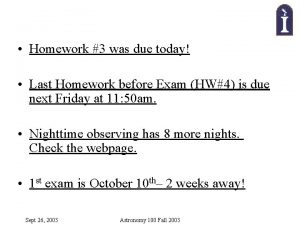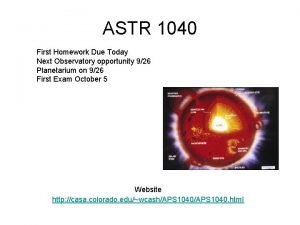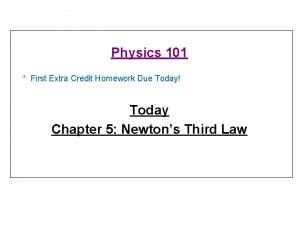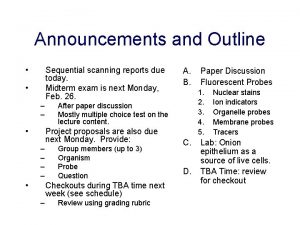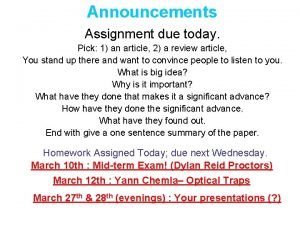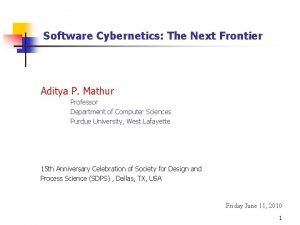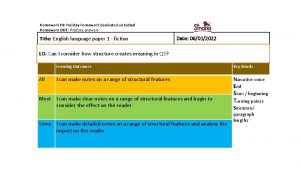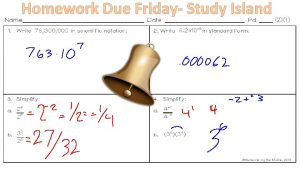Homework 5 was due today Next homework is







































- Slides: 39

• Homework #5 was due today. • Next homework is #6– due next Friday at 11: 50 am. • There will be another make-up nighttime observing session in November. Stay tuned. • I will be teaching Paul’s class on Monday, so my office hours will be cancelled. Oct 24, 2003 Astronomy 100 Fall 2003

Outline • • • HST & JWST CARMA and ALMA SOFIA Chandra Blackbodies – Wavelength of light corresponds to temperature – Brightness of light corresponds to temperature • Doppler Effect Oct 24, 2003 Astronomy 100 Fall 2003

HST • Hubble Space Telescope was launched April 24, 1990, 8: 33: 51 a. m– pad B. • Is a 2. 5 m reflecting telescope. • Initially had a mirror error, but it was fixed by serving mission. Oct 24, 2003 Astronomy 100 Fall 2003

HST Without the atmosphere, can take much better images of astronomical sources– even with smaller mirror. Oct 24, 2003 Astronomy 100 Fall 2003

JWST • • The next space telescope– 2011 The James Webb Space Telescope Observe in the near and mid-infrared Will be the biggest telescope in space– 6 meters! (Must fold up for launch) • Mirror is expected to weigh 1/3 rd as much as HST • Will take 3 months to reach position– no service missions • http: //www. gsfc. nasa. gov/gsfc/spacesci/pictures/20020806 ngst/AL-TRW-%20 Close%20 up%20 of%20 telesco. mpg Oct 24, 2003 Astronomy 100 Fall 2003

Very Large Array • Radio observatory of 27 antennas each 25 meters (82 ft) weighing 230 tons in Socorro, NM • Longest separation is 36 km (22 miles) Oct 24, 2003 Astronomy 100 Fall 2003 http: //www. vla. nrao. edu/

BIMA A millimeter array of telescopes owned and operated by UC Berkeley, UIUC, and UMd in Hat Creek, California. Wavelength of 3 millimeters – frequency of 115 GHz. Works night and day. Why? Oct 24, 2003 Astronomy 100 Fall 2003

BIMA Oct 24, 2003 Astronomy 100 Fall 2003

BIMA Oct 24, 2003 Astronomy 100 Fall 2003

BIMA Oct 24, 2003 Astronomy 100 Fall 2003

The Future -- 2005 + OVRO 10 X 6 m 8000 ft + = Cedar Flats Oct 24, 2003 Astronomy 100 Fall 2003 6 X 10. 4 m

Future of High Res mm/Sub-mm ALMA -- 2010 64 x 12 m @ 16, 400 ft Chajnantor Chile Oct 24, 2003 Astronomy 100 Fall 2003

Stratospheric Observatory For Infrared Astronomy SOFIA • Modified Boeing 747 SP • Operation height: 39000 to 45000 ft (11. 8 to 13. 7 km) • 2. 7 m telescope Cassegrain with Nasmyth focus • 20000 kg TA (f/19. 6 from 0. 3 to 1600 m) • Image stability goal 0. 2” RMS • Image quality 80% enclosed at 1. 5” circle • First Light – Oct 2004 • 20 year operations (3 to 4 flights per week) http: //www. united-sofia. com/Farout_2_frm. htm Oct 24, 2003 Astronomy 100 Fall 2003

Oct 24, 2003 Astronomy 100 Fall 2003

Oct 24, 2003 Astronomy 100 Fall 2003

The Mirror Oct 24, 2003 Astronomy 100 Fall 2003

FIFI LS: Far-Infrared Field-Imaging Line Spectrometer Oct 24, 2003 Astronomy 100 Fall 2003

FIFI LS Vacuum Vessel Status All 3 vessel shells manufactured Oct 24, 2003 Astronomy 100 Fall 2003

Optics Oct 24, 2003 Astronomy 100 Fall 2003

X-ray Telescopes Riccardo Giacconi – discovery of extrasolar X-ray sources (1962) and construction of the first imaging X-ray telescope (1963) Oct 24, 2003 Astronomy 100 Fall 2003

Sounding rocket observations (1960 s) X-rays from space detectable at these altitudes Altitude (km) 200 150 100 50 0 http: //www. boulder. swri. edu/~hassler/rocket/movie_gallery/36_171_onboard. mov Oct 24, 2003 Astronomy 100 Fall 2003

Chandra X-ray Observatory Launched 1999 Crab Nebula in X-rays Oct 24, 2003 Astronomy 100 Fall 2003

Multi-Wavelength Observations Oct 24, 2003 Astronomy 100 Fall 2003

The Multi-Wavelength Solar System Ultraviolet Visible Radio Infrared http: //www. ipac. caltech. edu/Outreach/Multiwave/gallery. html Oct 24, 2003 Astronomy 100 Fall 2003

Blackbody Radiation • Light that objects emit because of their temperature is called blackbody radiation • Blackbody radiation is composed of a continuous spectrum of wavelengths • The hotter an object gets, the more intense and shorter wavelength (bluer) its blackbody radiation becomes Infrared picture of a cat Visible-light picture of a cat (Temperature 312 K) Visible-light picture of a stove element (Temperature ~ 400 K) Oct 24, 2003 Astronomy 100 Fall 2003

Glowing Bodies • So, everything we know is in fact giving off light– as long as it has a temperature, it is glowing. • The higher the temperature the shorter the wavelength it glows in – compare the person in the bottom left (near infrared) and a light bulb (in the visible). http: //www. x 20. org/thermal_weapon_sight_TIWS 320. htm Oct 24, 2003 Astronomy 100 Fall 2003

Orion in Visible and IR Oct 24, 2003 Astronomy 100 Fall 2003

The Spectrum of Blackbody Radiation • As temperature increases, peak shifts to shorter wavelengths • The Sun’s spectrum looks almost like a 5800 K blackbody Oct 24, 2003 Astronomy 100 Fall 2003

Wein’s Law • The peak of the blackbody emission is inversely related to the temperature • The hotter the object, the stronger it emits light in the shorter wavelengths. • The Sun’s Photosphere is around 5800 K • Red hot? Or Blue hot? Color of stars? Oct 24, 2003 Astronomy 100 Fall 2003

Stephan-Boltzmann Law • For blackbodies, the brightness, or intensity, or output energy, is proportional to T 4 (in Kelvin). • If a star was the same size as the Sun, but was twice as hot, it would be 16 times as bright. Oct 24, 2003 Astronomy 100 Fall 2003

Doppler Effect Those of you use to racing events like the Indy 500, or the sound of a police siren, are use to the Doppler effect. Oct 24, 2003 Astronomy 100 Fall 2003

The Doppler Effect The effect arises from the relative motion of the observer and the source of light, sound, etc. The waves get squashed in the direction of motion and stretched in the opposite direction. Source standing still Oct 24, 2003 Source moving to right Astronomy 100 Fall 2003

The Doppler Effect The amount of the shift in wavelength depends on the relative velocity of the source and the observer Oct 24, 2003 Astronomy 100 Fall 2003

A Glass of Water molecules 1 nm = 10 -9 m 10 cm Oxygen atom 0. 1 nm Oxygen nucleus 1 fm = 10 -15 m Oct 24, 2003 Astronomy 100 Fall 2003

Protons, neutrons, and electrons Electrons Negatively charged (charge -1) Lightweight (mass 9. 110 x 10 -28 g) Protons Positively charged (charge +1) 1832 times as massive as an electron (mass 1. 673 x 10 -24 g) Neutrons No electric charge A little more massive than a proton (mass 1. 675 x 10 -24 g) Oct 24, 2003 Astronomy 100 Fall 2003

Atomic Structure Electrons orbit the nucleus of each atom (a little like planets around the Sun) The nucleus consists of protons and neutrons Number of protons = number of electrons (so total charge is 0) The electrons can only have special orbits called energy levels – the lowest energy level is the ground state Only 4 levels shown Ground state Hydrogen atom Oct 24, 2003 Astronomy 100 Fall 2003

The Periodic Table of the Elements The number of protons in an atom determines the type of element Oct 24, 2003 Astronomy 100 Fall 2003

Fraunhofer and Spectral Lines Discovered that Sun’s spectrum contained narrow gaps (spectral lines) when viewed at high resolution (1814) Oct 24, 2003 Astronomy 100 Fall 2003 Prism spectrograph

Absorption Lines Oct 24, 2003 Astronomy 100 Fall 2003
 X.next = x.next.next
X.next = x.next.next Homework due today
Homework due today Homework due today
Homework due today Homework due today
Homework due today Homework due today
Homework due today Homework due today
Homework due today Homework
Homework Homework due today
Homework due today Today's lesson or today lesson
Today's lesson or today lesson Are you going to class today
Are you going to class today Today's lesson or today lesson
Today's lesson or today lesson Today meeting or today's meeting
Today meeting or today's meeting Fingerprint ridge characteristics worksheet
Fingerprint ridge characteristics worksheet Today meeting or today's meeting
Today meeting or today's meeting Reports due today!
Reports due today! Liver blood supply
Liver blood supply Assignment due today
Assignment due today Assignment due today
Assignment due today James webb nasa space telescope launch
James webb nasa space telescope launch Assignment due today
Assignment due today Procedural vs substantive due process
Procedural vs substantive due process Grande rhetra
Grande rhetra Principio di conservazione della quantità di moto
Principio di conservazione della quantità di moto Quattro angoli retti
Quattro angoli retti How did you finish your homework?
How did you finish your homework? Homework is due
Homework is due Homework is due on friday
Homework is due on friday Homework is due on friday
Homework is due on friday Ilegalism
Ilegalism Literal language example
Literal language example Jack prelutsky homework oh homework
Jack prelutsky homework oh homework Homework oh homework poem
Homework oh homework poem Homework oh homework
Homework oh homework Homework oh homework i hate you you stink
Homework oh homework i hate you you stink Homework oh homework i hate you you stink
Homework oh homework i hate you you stink Next generation trading platform
Next generation trading platform Dollar up activities
Dollar up activities Be next frontier software development
Be next frontier software development The next generation
The next generation Datev auftragswesen next
Datev auftragswesen next

